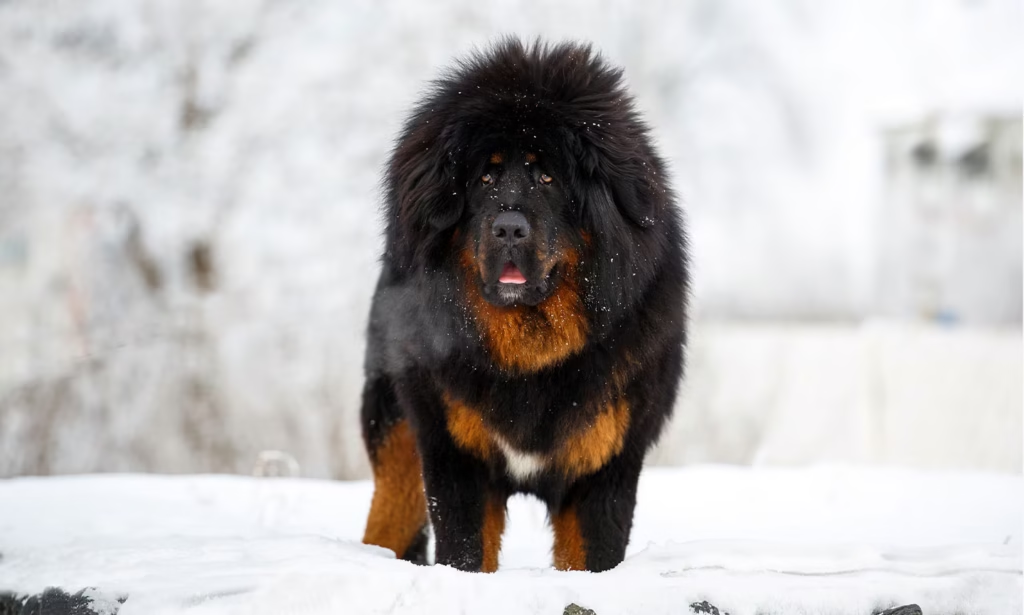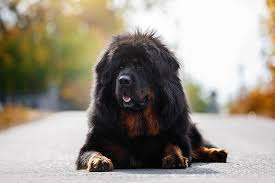Introduction
The Tibetan Mastiff is a powerful, ancient dog breed known for its majestic presence, loyalty, and protective instincts. Originally bred to guard livestock in the Himalayan mountains, these dogs are independent, strong-willed, and deeply devoted to their families. Though not ideal for first-time dog owners, the Tibetan Mastiff can be an exceptional companion for experienced owners who respect its unique temperament.

Origin and History
The Tibetan Mastiff has a rich heritage dating back thousands of years. Native to Tibet and its neighboring Himalayan regions, this breed was developed to protect sheep from predators such as wolves, leopards, and even snow leopards.
Learn more about: Labradoodle
Historically, Tibetan Mastiffs guarded monasteries and villages and were often tied outside homes as watchful guardians. Their aloof demeanor and thunderous bark made them excellent deterrents to intruders.
During the 19th century, the Tibetan Mastiff caught the attention of dog enthusiasts worldwide as it was brought to Europe and later to North America. Despite modern adaptations, the Tibetan Mastiff retains its ancient guarding instincts.
Physical Characteristics
| Trait | Description |
|---|---|
| Size | Large to giant |
| Weight | 70–150 lbs (31–68 kg) |
| Height | 24–30 inches (61–76 cm) |
| Coat Type | Double coat, thick and heavy |
| Colors | Black, brown, blue-gray, red-gold |
| Lifespan | 10–12 years |
Tibetan Mastiffs are notable for their dense fur resembling a mane around the neck, a sturdy frame, and a bushy tail that curls gracefully over their back. Males are usually larger and more imposing than females.
Temperament and Personality
The Tibetan Mastiff is dignified, independent, and protective. Though often reserved around unfamiliar people, they form deep, unwavering bonds with their family members. They are naturally territorial and may act reserved around unfamiliar people or animals.
Key traits include:
- Protectiveness: Natural guardians, they take their role seriously.
- Independence: Not a “people pleaser” like Golden Retrievers.
- Affectionate with family: Calm and gentle with loved ones.
- No-nonsense barkers: Will alert you loudly to anything unusual.
Socialization from a young age is crucial to prevent overly territorial behavior and ensure they grow into well-adjusted adults.
Ideal Living Environment
Tibetan Mastiffs thrive in environments that offer:
- Space to roam (preferably a large, securely fenced yard)
- Cooler climates (they do not do well in heat)
- Experienced owners who understand large guardian breeds
They are not suitable for apartment living due to their size and strong guarding tendencies. These dogs need a calm, structured home where boundaries are set.
Training and Socialization
Because of their strong-willed personality, teaching a Tibetan Mastiff requires patience and can be a rewarding yet demanding experience. They are intelligent but independent, often questioning commands.
Training Tips:
- Start early: Begin socialization and obedience as a puppy.
- Be consistent: Use firm but positive reinforcement.
- Avoid harsh methods: They respond poorly to forceful discipline.
- Exposure to different situations: This helps reduce territorial aggression.
Professional obedience classes can be beneficial, especially for new owners of guardian breeds.
Exercise Needs
Despite their size, Tibetan Mastiffs do not require excessive physical activity. Tibetan Mastiffs have a balanced energy level but still need regular physical activity and mental engagement each day to maintain their well-being.
Ideal activities include:
- Daily walks (30–45 minutes)
- Playtime in a secure yard
- Mental stimulation through training or puzzles
Because Tibetan Mastiffs are sensitive to heat, it is best to limit strenuous exercise when temperatures are high.
Grooming Requirements
This breed features a dense, two-layered coat that sheds heavily during certain times of the year. Weekly brushing is typically enough, except during shedding season, when daily grooming may be needed.
Grooming essentials:
- Brush once or twice a week.
- Bathe monthly or when dirty.
- Trim nails regularly
- Clean ears and check for infections
- Brush teeth several times a week.
During the spring or fall “blowout” season, expect a significant amount of fur loss.
Health and Common Issues
Although typically robust, Tibetan Mastiffs may be susceptible to specific health issues:
- Hip and elbow dysplasia
- Hypothyroidism
- Entropion (inward-rolling eyelid)
- Progressive retinal atrophy (PRA)
- Canine inherited demyelinating neuropathy (CIDN)
Health Tips:
- Always purchase from a breeder who screens for genetic diseases.
- Annual vet checkups are essential.
- Maintain a healthy weight to reduce joint strain.
Diet and Nutrition
A well-balanced diet plays a vital role in supporting the health and lifespan of a Tibetan Mastiff. Their diet should be:
- High in protein and moderate in fat
- Free of unnecessary fillers
- Portion-controlled to avoid obesity
Puppies need a specially formulated large-breed puppy diet to support proper bone development. Fresh water should always be available.
Tibetan Mastiff with Kids and Pets
With Children:
Tibetan Mastiffs can be gentle and protective with children, especially those in their household. Nonetheless, because of their large size and power, close supervision is advised.
With Other Pets:
They may occasionally show caution or territorial behavior toward other dogs, especially those of their sex. Early socialization helps. Their guarding instincts may also trigger prey drive with smaller animals.
Advantages and Disadvantages of Caring for a Tibetan Mastiff
✅ Pros:
- Excellent guard dog
- Loyal and affectionate with family
- Low-maintenance exercise needs
- Independent and intelligent
❌ Cons:
- Not ideal for first-time owners
- Aloof or aggressive with strangers
- Heavy seasonal shedding
- Can be stubborn and strong-willed
Is This Breed Right for You?
A Tibetan Mastiff may be perfect for you if:
- You have experience with large or guardian breeds.
- You live in a home with space and secure fencing.
- You value loyalty, independence, and strong protective instincts.
- You are prepared for early training and lifelong socialization.
If you are seeking an easy-going, dog-park-loving pup, this might not be the best fit.
Frequently Asked Questions (FAQs)
With the right training and early socialization, they often become affectionate and devoted pets, particularly suited for families with older kids.
Not inherently, but they are naturally territorial. Without proper socialization, their guarding behavior can escalate.
Not comfortably. They prefer cooler environments and can overheat easily due to their thick coat.
They are known for their loud, deep bark, especially at night if they sense something unusual.
They are intelligent but can be stubborn. Consistent, positive reinforcement is key.
Conclusion
The Tibetan Mastiff is not a dog for everyone, but for the right owner, it is a fiercely loyal, noble, and protective companion. With its majestic appearance, centuries-old heritage, and independent spirit, the breed continues to command respect and admiration worldwide.
Before bringing a Tibetan Mastiff into your home, ensure you are prepared for the responsibility that comes with owning such a powerful and ancient breed. In return, you’ll gain a devoted friend who’ll guard your heart and your home.


Pingback: Borzoi Dog Breed: Temperament, Care, Traits & More -